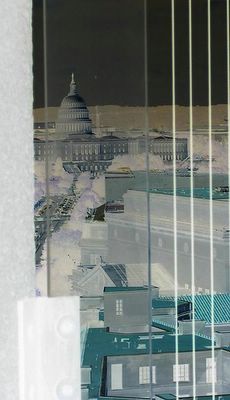COMMUTING: Transit Riders Unite? Straphangers' Union Coming Soon, Perhaps
Postings from a washingtonpost.com transportation chat from Monday is causing confusion. Washington Post reporters Lyndsey Layton and Steven Ginsberg got all giddy for a second when someone submitting a question said that a new WMATA commuters' union was in the initial stages of formation. But by the end of the day, all traces of the commuter union vanished from the chat, sans a reference to one person telling them to reference the earlier post on the commuter coalition.
This leaves the Oculus very confused. Why was the news of the commuter union edited out in the final version? The prospects of a commuter union is probably the best news for area transit riders in a long time. Such an assocation would be similar to New York's famed Straghangers Campaign.
Such a union could provide aid to distressed commuters, like this one from the chat:
I dutifully purchased and registered my SmarTrip card, and used it daily. It stopped working, so following instructions, I filled out the yellow Metro envelope and mailed it in. That was over three weeks ago and I still have not received my replacement card. Now, here's the most aggravating part: SmarTrip people are unreachable. I've e-mailed them to the address from the Web site, I've sat on hold waiting for an operator for 25 mins. at a time, I've left messages asking for a phone call in return. Nothing. What do I do now? I have $100 sitting on that card!
The washingtonpost.com chat also revealed some additional interesting items.
Remember when I posted about bunching buses on the 30-series bus line? Here's Lyndsey Layton's explantion after someone asked a question as to why buses often run in bunches.
Hi D.C., You're refer to the phenomenon known in transit circles as "bunching" and, as a daily bus rider myself, I understand your annoyance. When buses bunch, it often is because of traffic conditions - it only takes a snarled intersection for buses on a single line to catch up to one another and stall in traffic together. But sometimes, it's an indication that the drivers are fooling around. I've heard complaints from some bus drivers who say that less conscientious colleagues intentionally start their runs late and fall in behind other buses, so they don't have to pick up passengers. Seems they like their space on their big, empty buses.
And to clarify something from the chat. A reader in Woodbridge, Va., seems to say the region's traffic is so bad in part because of residental pressure in Georgetown to keep metrorail out.
That is only partially true. According to George Mason University assistant professor Zachary Schrag, who has done extensive research on the development of the metrorail system, geography had much more of role in derailing a Georgetown station. In a 2001 interview on WAMU's Metro Connection program, Schrag contends that if Georgetown were to have a metrorail station, it would a) be very, very deep below M Street; b) follow an awkward tunnel alignment that would c) require a rail bridge over the Potomac to Rossyln, not a tunnel. The Rosslyn-Foggy Bottom tunnel alignment was easier to construct than a massive infrastructure undertaking via M Street.
That isn't to say there weren't residents in Georgetown who were opposed to the station; it is just that geography played just as big of a role in the alignment of the Blue and Orange line subway.



0 Comments:
Post a Comment
<< Home